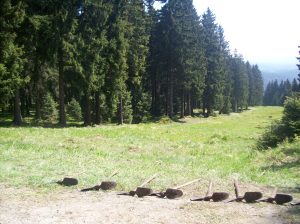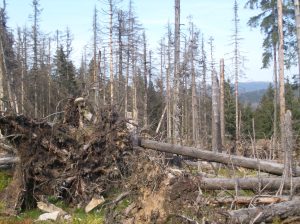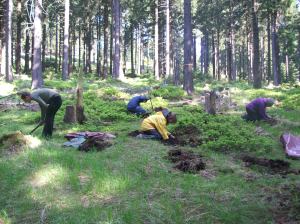(Deutsch unten)
 2011 is the “International Year of Forests”, with endless opportunities to plant trees with a donation or a click of the mouse. I tried out the hands-on experience in the first, sunny-snowy week of May in Germany’s Harz Mountains as a volunteer for the Bergwaldprojekt.
2011 is the “International Year of Forests”, with endless opportunities to plant trees with a donation or a click of the mouse. I tried out the hands-on experience in the first, sunny-snowy week of May in Germany’s Harz Mountains as a volunteer for the Bergwaldprojekt.
The initiative, founded in Switzerland in 1987, organizes “ecological volunteer work assignments in the forest” in order to “draw attention to the forest’s problems; promote understanding of natural ecosystems, forest concerns and the key importance of forests as a basis of human existence; and work toward improving ecological and political parameters.” The Bergwaldprojekt has been active in Germany for 20 years, with more than 25 project sites from Amrum to Oberammergau, and has launched pilot projects in Catalonia and the Carpathian Mountains in Ukraine. I hope to delve into the history of this fascinating project in a later entry.
But what is the “work assignment” actually like? A group of 20 people of all ages, including several handicapped students from the Hildesheim Luise-Scheppler Schule, overseen by the landscape manager Axel Jakob, forest historian Cai-Olaf Wilgeroth, Tamara Bös (environmental protection technician), Tim Pflügner (International Forest Ecosystem Management) and Christian Struve, a ranger at the Harz National Park. Room and board are free, with accommodations in a ski lodge and plentiful meals (“So far no one has ever lost weight at the Bergwaldprojekt!”).

Wiedehopfhauen
We get up at 6, eat breakfast, do the dishes, form groups, are driven to the work site in vans (we had a choice between planting trees, fence- and bridge-building), work, have a second breakfast at 10, back to work, lunch, back to work, back to the ski hut around 5 p.m., dinner, dishes, have a beer, fall into bed. The harmless-sounding “planting” turns out to be back-breaking labor on these stony Harz slopes; the tool we use looks like a medieval battle weapon and is called a “Wiedehopfhaue”. Very quickly we start picking up the technical terms and talking shop.
Perhaps the most rewarding part of the project, apart from the very enjoyable group, was the glimpse it provided into the language and logic of a type of work that is rather exotic for desk workers. It was a challenge, above all physically, but the project supervisors were very good at accepting each person’s limits yet pushing us to achieve the best we could. Our goal for the week was 3000 trees – and sloppily planted trees would have to be replanted by the forest workers. We rapidly gained respect for this work, which can be quite tricky – beech saplings are sensitive and demanding creatures. It soon became clear that forestry is not only a physically wearing and occasionally dangerous profession, it also requires a great deal of knowledge, passion for detail and the ability to think in terms of complex interrelationships – and incredibly long timeframes.
Our planting assignment, for instance, was just a tiny part of a broad strategy to – so to speak – recreate the primeval forest in the National Park. In the Harz very little if any “primeval forest” has survived. This has been a mining region ever since the Middle Ages – on a huge scale, as a visit to the Samson Mine in Sankt Andreasberg made clear. The original mixed deciduous forest was used up entirely, in large part as charcoal for metal smelting, and replaced with fast-growing spruce. But this sort of monoculture is highly problematic, hosting little species diversity and vulnerable to bark beetle infestations or storms. And spruce is adapted to higher altitudes, better suited to cold than to hot dry weather – which, incidentally, is the favorite weather of the bark beetle. And climate change will bring both storms and heat waves…
According to the website of the National Park:
“Forests are always in motion. If humans do not intervene, they follow their own laws. But human beings used the forest too intensively over the past centuries, so we must now help the cultivated forest turn back into a natural forest. In parts of the National Park that are already in a near-natural state, we simply leave the forest alone and trust to its own dynamics (natural dynamics zone). In other areas we give it gentle assistance, keeping bark beetles away or encouraging the life cycle of growth and decay (natural development zone).”
“Gentle assistance” means above all planting beeches, the tree that dominated before the massive clearings of the Middle Ages. They are better adapted to the warmer climate of lower altitudes, but cannot make headway against the armies of spruce without our help. We managed to plant 3400 beeches that week – but time is running short.
“Our goal is that by 2022 we will be able to leave at least 75 % of the National Park’s area to its own resources as part of the natural dynamics zone.”
At this time the natural dynamics zone accounts for only 41% of the National Park… so there is plenty of work to be done! 10 more years of intensive labor – then the human helpers will step back and watch what happens.

Bark beetle forest
The park’s motto is “let nature be nature” – but the result can be disconcerting. At the end of the week ranger Christian Struve took us to the top of the Bruchberg mountain, where the bark beetle ran riot several years ago. At that time the National Park made the decision to let bark beetles be bark beetles and refrain from taking counter measures. This left behind an eerie landscape, with withered dead trees as far as the eye can see – but between them spruce saplings have shot up, and shrubs, grasses and flowers flourish in the sunny, open spaces. In fact, Struve explained, there is much more species diversity here than in an intact, monoculture forest. And the new spruce forest that emerges will be more structurally varied and less vulnerable than the old spruce plantation. For him, the “bark beetle forest” is above all an exciting, hopeful experiment.
In the nearby town of Ilsenburg, however, I had seen posters protesting the National Park’s bark beetle policy: the town’s once-picturesque forest backdrop has been devastated, and inhabitants have accused the National Park of negligence. Are these conflicts of interest between the National Park and the local population a common occurrence? Of course, Struve said, but the key thing is to communicate the positive aspects of the “bark beetle forest” experiment, educating the population about the new, diverse life that is emerging here. And in fact the National Park has done exactly that in Ilsenburg:
“The damage done by the bark beetle can already be seen from the valley, from Ilsenburg. The damage to tourism in the popular Ilse Valley, sung by Heinrich Heine, is immeasurable. But we have made a virtue out of necessity, offering National Park visitors a unique attraction, the so-called Bark Beetle Trail. … With its many information stations, it helps visitors understand why this catastrophe is also an opportunity.”
The “bark beetle forest” calls into question conventional notions of idyllic nature, revealing the paradoxical interplay between natural processes and human expectations and decisions. Similarly, in a hundred years the “primeval forest” we planted could provoke reflections on the symbiosis between forest and humanity. But by then most people will probably take it for granted as a part of nature. Which, of course, it is. As are we.
***
 2011 ist das internationale „Jahr der Wälder“, mit unendlich vielen Möglichkeiten, per Mausklick oder Spende Bäume pflanzen zu lassen. Wie das vor Ort aussieht, erlebte ich in der ersten sonnig- bis schneeigen Maiwoche im Harz bei einem Einsatz des Bergwaldprojekts.
2011 ist das internationale „Jahr der Wälder“, mit unendlich vielen Möglichkeiten, per Mausklick oder Spende Bäume pflanzen zu lassen. Wie das vor Ort aussieht, erlebte ich in der ersten sonnig- bis schneeigen Maiwoche im Harz bei einem Einsatz des Bergwaldprojekts.
Die Initiative, 1987 in der Schweiz gegründet, organisiert „freiwillige ökologische Arbeitseinsätze im Wald“, um „auf die Probleme des Waldes aufmerksam [zu] machen, das Verständnis für die Zusammenhänge in der Natur, die Belange des Waldes und die Abhängigkeit des Menschen von diesen Lebensgrundlagen [zu] fördern und auf die Verbesserung der ökologischen und politischen Rahmenbedingen hin[zu]wirken.“ Inzwischen ist das Bergwaldprojekt seit 20 Jahren auch in Deutschland aktiv – mit über 25 Einsatzorten von Amrum bis Oberammergau – und hat Pilotprojekte in Catalunya und in den ukrainischen Karpathen gestartet. Auf die Hintergründe des spannenden Projektes möchte ich in einem späteren Eintrag eingehen.
Wie sieht aber nun der konkrete Arbeitseinsatz aus? Eine Gruppe von 20 Menschen aller Alterstufen, auch einige behinderten SchülerInnen der Hildesheimer Luise-Scheppler Schule, Betreuung der Gruppe durch den Landschaftspfleger Axel Jakob, Forsthistoriker Cai-Olaf Wilgeroth, Tamara Bös (Umweltschutztechnikerin), Tim Pflügner (International Forest Ecosystem Management) und Christian Struve, Ranger des Nationalparks Harz. Kost und Logis sind umsonst: Unterbringung in einer Skihütte, Rundumverpflegung („Noch keiner hat beim Bergwaldprojekt abgenommen!“).

- Wiedehopfhauen
Aufstehen um 6, Frühstück, abwaschen, Gruppen bilden, in Kleinbussen zum jeweiligen Einsatzort fahren (Bäume pflanzen, Brücke- und Gatterbau), arbeiten, zweites Frühstück um 10, weiter arbeiten, Mittagessen, weiter arbeiten, gegen 17 Uhr wieder in die Hütte, Abendessen, abwaschen, Bierchen trinken, ins Bett fallen. Das harmlos klingende „Bäumchenpflanzen“ erweist sich am steinigen Harzer Hang als Knochenarbeit, das Werkzeug heißt „Wiedehopfhaue“ und sieht aus wie eine mittelalterliche Nahkampfwaffe. Solche Begriffe schnappt man auf und fängt gleich an zu fachsimpeln. Wir arbeiten z. B. nicht etwa „im Wald“, sondern „auf der Fläche“.
Das vielleicht Schönste an dem Projekt, abgesehen von der netten Gruppe, war eben der Einblick in die Sprache und Logik dieser (für Schreibtischmenschen doch exotischen) Arbeit. Eine Herausforderung, vor allem auch körperlich, aber die Projektleiter verstanden es sehr gut, unsere jeweiligen Grenzen zu akzeptieren, uns aber dennoch zu ordentlichen Leistung anzutreiben. Denn wir hatten ein Wochenpensum von 3000 Bäumen – und schlampig gepflanzte Bäume würden die Forstleute neu pflanzen müssen. Man bekommt schnell Respekt vor dieser Arbeit, die auch ziemlich kniffelig ist – Buchensetzlinge sind empfindliche Wesen. Überhaupt wird klar, daß die Waldarbeit nicht nur ein körperlich belastender und zuweilen gefährlicher Beruf ist, er fordert auch sehr viel Wissen, Liebe zum Detail und ein Denken in komplexen Zusammenhängen – und in schwer vorstellbaren Zeiträumen.
Unsere Pflanzaktion war nämlich Teil einer breitangelegten Strategie, im Nationalpark den Urwald – sozusagen – wieder herzustellen. Denn im Harz hat wenig oder gar kein „Urwald“ überlebt. Hier wurde schon seit dem Mittelalter Bergbau betrieben – im großen Maßstab, wie ein Besuch in der Grube Samson (Sankt Andreasberg) vor Augen führte. So wurde der ursprüngliche Laubmischwald u.a. als Holzkohle für die Metallverhüttung verfeuert und mit schnell wachsenden Fichten ersetzt. Solche Monokulturen sind aber hochproblematisch: sie beherbergen wenig Artenvielfalt und sind anfällig für Borkenkäfer oder Stürme. Außerdem ist die Fichte nur in den höheren Lagen „standortgerecht“; sie verträgt Kälte viel besser als heißes, trockenes Wetter – übrigens das Lieblingswetter des Borkenkäfers. Und der Klimawandel bringt sowohl Stürme als auch Hitze…
Auf der Webseite des Nationalparks heißt es:
„Wälder sind in Bewegung. Wenn Menschen nicht eingreifen, folgen sie ihren eigenen Wald-Gesetzen. Weil aber der Mensch den Wald in den vergangenen Jahrhunderten zu stark nutzte, müssen wir dem Kultur-Wald helfen, wieder zu einem Natur-Wald zu werden. Im Nationalpark überlassen wir den Wald in bereits naturnahen Gebieten einfach sich selbst und vertrauen auf seine Kräfte (Naturdyamikzone). In anderen Bereichen helfen wir ihm sanft auf die Sprünge, halten den Borkenkäfer fern oder fördern den Kreislauf des Lebens aus Werden und Vergehen (Naturentwicklungszone).“
„Auf die Sprünge helfen“ heißt vor allem Buchen pflanzen, die Baumart, die vor den großen Rodungen des Mittelalters vorherrschte. Sie sind standortgerechter, d.h. wärmeliebend, können sich dennoch ohne menschliche Hilfe nicht gegen die Armeen von Fichten durchsetzen. 3400 Stück haben wir in der Woche geschafft – aber die Zeit drängt. Denn:
„Unser Ziel ist es, dass bis zum Jahr 2022 mindestens 75 % der Nationalpark-Fläche sich selbst überlassen werden, also der Naturdynamikzone zugerechnet werden können.“
Zur Zeit beträgt die Naturdynamikzone nur 41% des Nationalparks… da bleibt also noch viel zu tun! Noch 10 Jahre intensiver Arbeit, dann zieht sich der Mensch zurück und schaut, was passiert.

- Borkenkäferwald
„Natur Natur sein lassen“ heißt die Devise – aber das Ergebnis kann auch befremdend wirken. Zum Abschluß der Woche führte uns der Ranger Christian Struve auf den Bruchberg, wo der Borkenkäfer vor mehreren Jahren gewütet hat. Ganz bewußt hat der Nationalpark damals den Borkenkäfer Borkenkäfer sein lassen und keine Gegenmaßnahmen ergriffen. So entstand eine auf dem ersten Blick gespenstische Landschaft. Dürre Baumleichen soweit das Auge reicht – dazwischen aber wachsen junge Fichten empor, auf den offenen, sonnigen Flächen gedeihen Sträucher, Gräser und Blumen. Tatsächlich, so Struve, herrscht hier eine viel größere Artenvielfalt als im intakten Forst. Und der neue Fichtenwald, der hier organisch entsteht, wird strukturreicher und weniger anfällig sein, als die alte Fichtenplantage. So stellt der „Borkenkäferwald“ für ihn ein spannendes und hoffnungsvolles Experiment dar.
Allerdings hatte ich im nahegelegenen Ilsenburg Protestplakate gegen die Borkenkäferpolitik des Nationalparks gesehen: die einst malerische Waldkulisse der Stadt ist weitflächig verwüstet, man wirft dem Nationalpark Fahrlässigkeit vor. Ob es öfters zu solchen Interessenkonflikten zwischen Nationalpark und Bevölkerung kommt? Freilich, meinte Struve, es komme aber darauf an, die positiven Seiten des Experiments „Borkenkäferwald“ zu vermitteln, die Bevölkerung über das neue vielfältige Leben aufzuklären, das hier entsteht. Tatsächlich handelt der Nationalpark bei Ilsenburg genau in diesem Sinne:
„Die Schäden, die der Borkenkäfer anrichtete, kann man schon vom Tal, von Ilsenburg aus sehen. Die Schäden für den Tourismus im beliebten, schon von Heinrich Heine besungenen Ilsetal sind unabsehbar. Doch nun hat man aus der Not eine Tugend gemacht und bietet Besuchern des Nationalparks Harz eine einzigartige Sehenswürdigkeit, den so genannten Borkenkäferpfad. … Mit zahlreichen Info-Stationen lässt [er] die Besucher verstehen, warum die Katastrophe eine Chance ist.“
Der „Borkenkäferwald“ stellt gängige Vorstellungen von Naturidylle in Frage, er offenbart das paradoxe Zusammenspiel zwischen natürlichen Prozessen und menschlichen Erwartungen und Entscheidungen. In hundert Jahren könnte der von uns gepflanzte „Urwald“ in ähnlicher Weise zum Nachdenken über die Symbiose Wald-Mensch anregen. Wahrscheinlich aber wird er bis dahin von den Meisten nur noch als selbstverständliches Teil der Natur wahrgenommen. Wobei, das ist er ja auch. Wie wir selbst.








